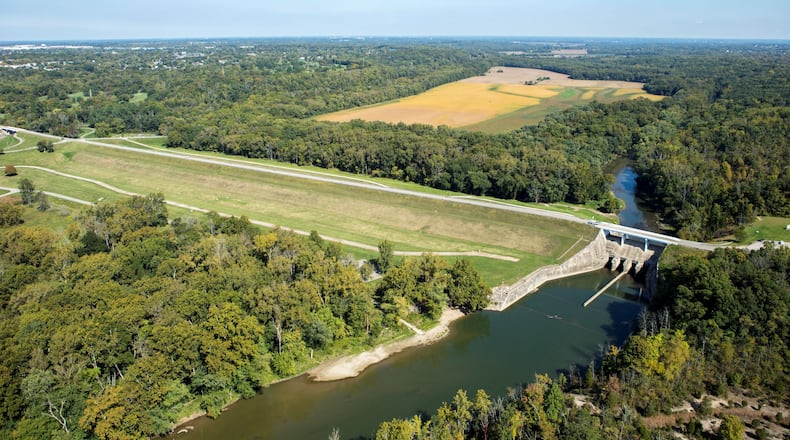In the long run, that won’t be enough, according to Miami Conservancy District officials.
The Miami Conservancy District has identified more than $30 million needed for work in the next few years to keep the region’s flood protection system healthy.
Looking out even further, they say $140 million is needed over time to address maintenance needs and increased stress on the flood control system caused by an aging infrastructure, climate change and other factors.
After an effort by the district to increase flood protection assessments faced public backlash, the district is looking at ways to collect funds to keep the system working. It could include expanding who pays for it, adding charges to tax bills of property owners far from the river.
Credit: Nick Graham
Credit: Nick Graham
This story looks at why the dam and levee system is facing expensive challenges.
The conservancy district maintains and operates the dam and levee system that protects thousands of properties from Piqua to Cleves.
“It’s important that we prioritize this work in the best way we can to ensure that we’re good stewards of the of the public money and of the public infrastructure that we’re responsible to maintain,” said Miami Conservancy District general manager MaryLynn Lodor.
A facelift for a 100-year-old system
The Miami Conservancy District’s flood protection system consists of five dry dams, five storage basins and 55 miles of levee. It spans throughout the the Great Miami River Watershed, which includes Montgomery, Greene, Shelby, Hamilton, Butler, Preble, Clark, Champaign, Miami, Darke, Warren and Logan counties.
Lodor said in the first 50 years of the dam system’s life, much of the work around it was geared toward day-to-day maintenance needs.
“The whole system was paid for by the locals, so they didn’t want to have to deal with high costs of capital rehab,” she said. “They were still paying off the system at that time. But that has resulted in a need, now, to do some of that rehab work that was not a part of the dam’s early years.”
The Conservancy Court, which consists of nine common pleas court judges from counties covered by the Miami Conservancy District, authorized $34.5 million in capital authority for the Miami Conservancy District. This funding will cover costs related to high-priority projects.
“We’re looking at those things very carefully, looking at the consequence of a failure and the likelihood of it. Those two things are really important for us to identify which projects are necessary for us to move forward with sooner than later,” Lodor said.
Most of these projects are a combination of concrete rehabilitation for the five dams and other improvement work at the levees.
Credit: Nick Graham
Credit: Nick Graham
The walls and spillways of the region’s five dams are made of concrete — hundreds of thousands of cubic yards of it, in fact. The last major concrete rehabilitation project at the dams was nearly 50 years ago. District officials said this rehab work is state-required, but also necessary to keep the structures functioning as designed.
Miles of earthen levee, too, need work. This includes the addition of internal cutoff walls, which would keep levees strong during severe storms. Work on levees in Huber Heights and Middletown is also a priority for the district.
Other work includes the rehabilitation of the Germantown Dam’s conduit floor and its emergency spillway, as well as the rehabilitation of a pump station in Piqua. The district is also planning a structural stability monitoring project at Lockington Dam.
The $34.5 million in approved project funding is an initial phase of a long-term $140 million capital project plan. District officials said this plan will be a phased approach, tackling work over time.
“We want to keep the levee strong. We want to keep the keep the dam strong,” she said.
Local impacts of climate change
Aging infrastructure, extreme weather events and increasing rainfall are putting pressure on the regional flood protection system, officials said.
Rainfall, on average, has increased over the past few decades. From 1951 to 1980, the region saw an average rainfall of 38 inches per year. But over the past three decades, that annual average has been closer to 42 inches.
According to the Miami Conservancy District, the flood protection system has seen an average of 21 storage events — times when rushing water is shifted to storage basins to prevent flooding — per year since the 1930s. But looking at the average number of storage events from 1990 to 2020, the average is closer to 28 storage events per year.
Rushing, forceful water causes the erosion of concrete used for dams. More frequent storage events mean more wear and tear on the system, and that means increased costs for operation and maintenance, according to the Miami Conservancy District manager for water resource monitoring and analysis Mike Ekberg.
“I see our dams, the concrete gets more high flows on an average year, that puts parts of the levee system under more stress more frequently,” Ekberg said. “It’s kind of like a set of running shoes. If you run 20 miles a week, there’s a certain amount of wear and tear. But if you start to run 40 miles a week, well, that sees more.”
District officials said they anticipate an increase in the number of storage events, frequency of storms, and severity of storms.
The flood protection system was designed for a storage event larger than the Great Flood of 1913. The system is expected to be resilient to climatic changes, provided the system is well maintained and functions as designed, according to the Miami Conservancy District.
But a changing climate has other consequences for the region’s dam and levee system. Drought conditions also impact the system because vegetation around the dams and levees is strategically used to hold stream banks in place, for example. Extreme weather events, like tornadoes, are also impacted by a changing climate.
Assessments, federal funding
The region’s dam and levee system was locally designed, locally constructed and, for more than 100 years, locally funded.
Much of the Miami Conservancy District’s work is funded through assessments that appear as charges on property owners’ tax bills. Roughly 39,000 properties in the region are charged for flood protection services.
The conservancy district has two charges: maintenance assessments, which cover costs related to day-to-day operations, and capital assessments, which cover costs related to larger-scale capital projects like dam rehabilitation and more.
The 3.35% maintenance assessment will generate $9.8 million annually, while the 1% capital assessment is estimated to bring in $2.9 million. According to the Miami Conservancy District, nearly 81% of properties charged with assessments pay less than $200 total. Roughly 3% of these properties pay more than $1,000.
Lodor said the conservancy district leverages state, federal and local dollars whenever possible. Federal funding for the work of the district, however, is limited.
The conservancy district had funding approved for $1.4 million in projects pre-approved through the Federal Emergency Management Agency.
This funding would have covered the costs of an evacuation plan for all five of the region’s dams, as well as a dam risk assessment, and analysis of erosion at Germantown Dam’s emergency spillway, and other work at the Taylorsville Dam.
Officials said that given changes on the federal level, these projects are now uncertain.
‘I’m hopeful’
In Butler County, Spooky Nook Sports at Champion Mill attracts thousands of families for sports tournaments. Before the reappraisal pause last year, business owner Sam Beiler said the location would see its flood control fees rise from $8,000 to nearly $500,000 per year.
“There appears to be an effort now to find a balance that accomplished what the MCD needs, which is improving and strengthening the flood control system. Which, I don’t know anyone who doesn’t support that,” Beiler said. “I think we’re on a good path, and I’m hopeful.”
Beiler said his business has had a great experience in Hamilton, and he wants to see the city thrive.
“We have such a solid respect for the city of Hamilton,” he said. “I hope to see the conservancy district and the people pull in the same direction.”
About the Author





